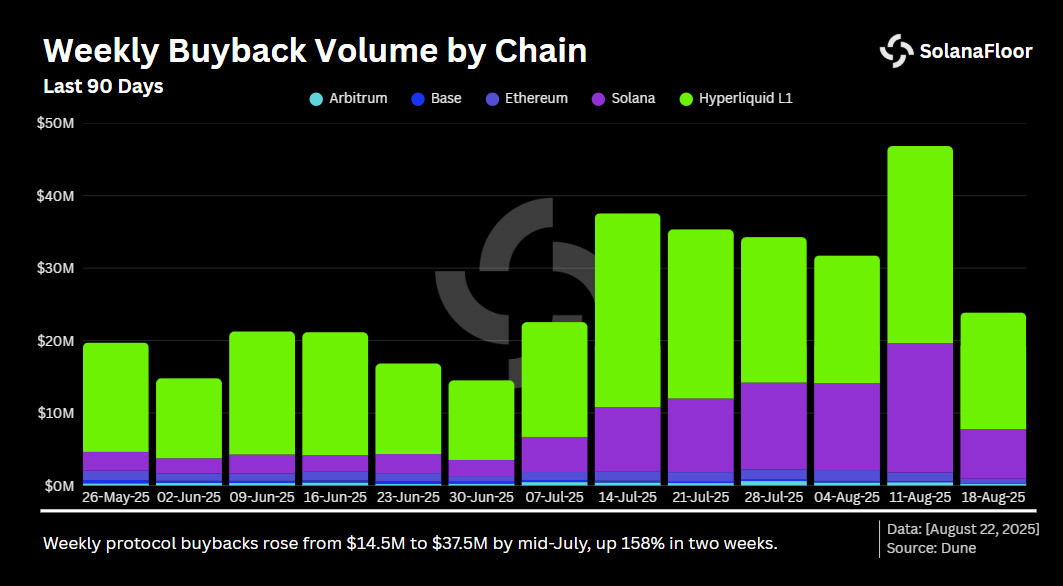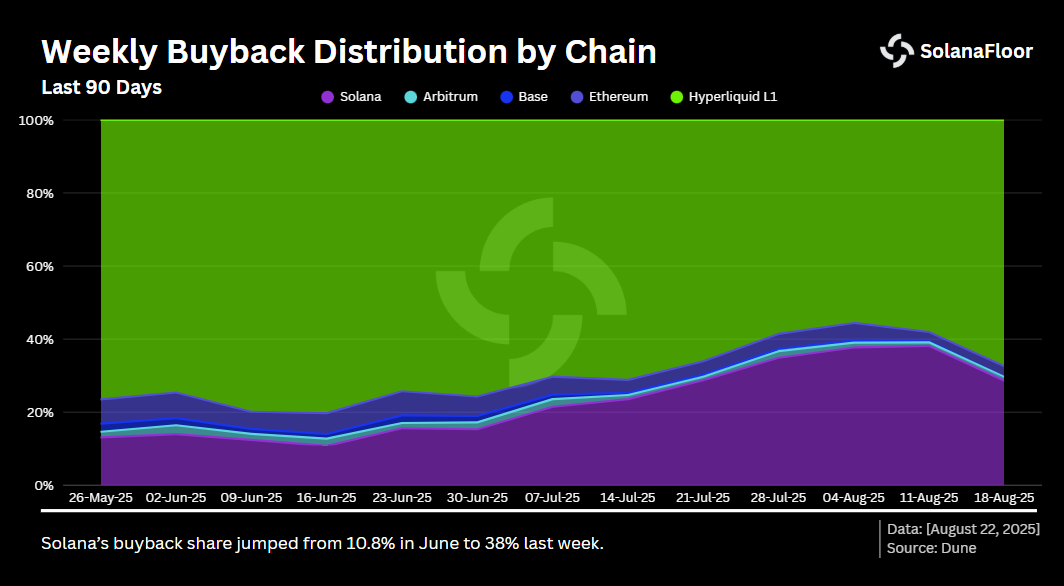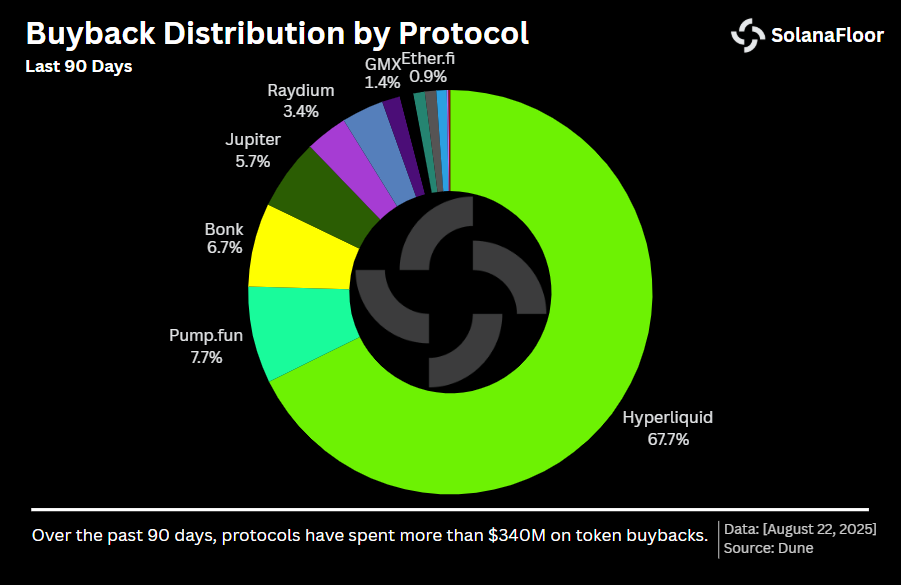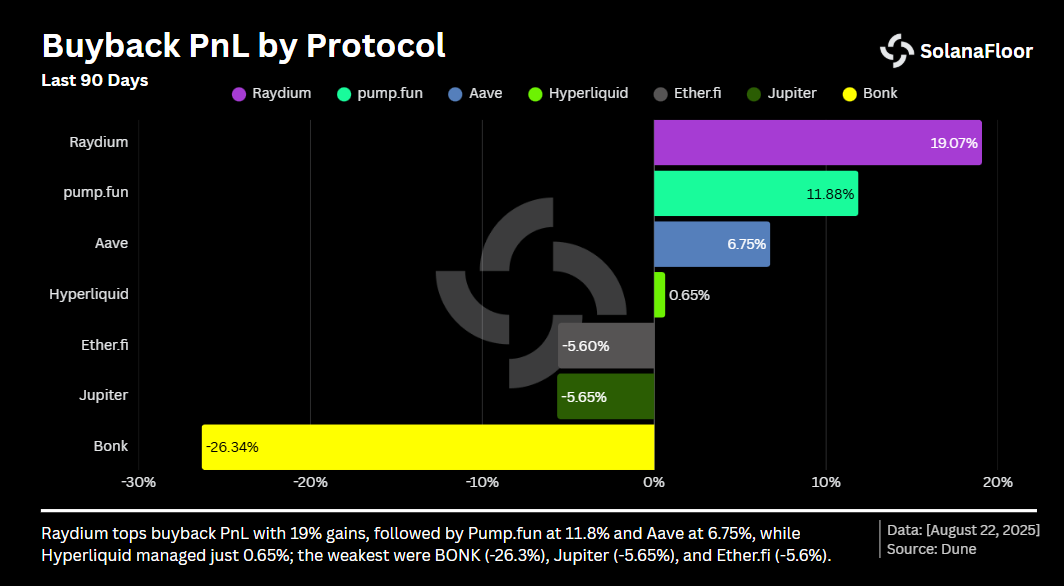
Solana Projects Account for 40% of all Weekly Token Buybacks Across Crypto, Delivering Value Back to Holders
Are token buybacks becoming the defining feature of crypto economics?
- Published:
- Edited:
In traditional finance, share buybacks have long been used by corporations to signal confidence, reduce supply, and return value to shareholders. A similar logic has begun to take hold in the cryptocurrency sector. Protocols are increasingly turning to token buybacks as a mechanism to stabilize prices, reduce circulating supply, and align incentives between teams and their communities.
Onchain Data: A Rapid Expansion
 Onchain data shows that token buybacks are no longer an occasional event but have grown into a consistent trend across ecosystems. According to Dune Analytics, weekly protocol buyback volume surged from roughly $14.5M in late June to more than $37.5M by mid-July, a 158% increase in just two weeks.
Onchain data shows that token buybacks are no longer an occasional event but have grown into a consistent trend across ecosystems. According to Dune Analytics, weekly protocol buyback volume surged from roughly $14.5M in late June to more than $37.5M by mid-July, a 158% increase in just two weeks.
Much of this growth came from Hyperliquid L1 and Solana-based protocols, which saw buyback volumes rise by 143% and 301%, respectively. Solana’s buyback volume more than quadrupled in that short span, and by the most recent week, total weekly buybacks reached a new high of $46.8M, led by Hyperliquid ($27.1M) and Solana protocols ($17.8M).
Shifting Market Share Between Chains
 The composition of buybacks across blockchains has shifted considerably over the last three months. Solana’s share of weekly protocol buybacks has climbed from just 10.8% in mid-June to more than 38% last week, largely at the expense of Hyperliquid and Ethereum.
The composition of buybacks across blockchains has shifted considerably over the last three months. Solana’s share of weekly protocol buybacks has climbed from just 10.8% in mid-June to more than 38% last week, largely at the expense of Hyperliquid and Ethereum.
Hyperliquid still commands the largest overall share, maintaining over 58% of the total, but the rise of Solana protocols signals a growing diversification. Ethereum, by contrast, has seen its share fall from 5.7% to only 2.5%.
Protocol-Level Strategies
Looking closer at individual protocols, clear patterns emerge. Hyperliquid, the largest perpetual trading platform, has been the most aggressive buyer, spending between $11M and $27M weekly on $HYPE repurchases over the last 90 days.
 In Solana’s ecosystem, a wide range of protocols are engaged in buybacks. Aggregator and DEX such as Jupiter and Raydium have maintained steady programs, with Jupiter committing between $1M and $2.3M weekly to repurchase $JUP, while Raydium has bought back between $500K and $1.5M of $RAY each week. Other protocols including Metaplex and Step Finance also allocate resources toward token buybacks. Step Finance, for example, has directed 100% of its revenue to purchase up to $120K of $STEP weekly over an extended period.
In Solana’s ecosystem, a wide range of protocols are engaged in buybacks. Aggregator and DEX such as Jupiter and Raydium have maintained steady programs, with Jupiter committing between $1M and $2.3M weekly to repurchase $JUP, while Raydium has bought back between $500K and $1.5M of $RAY each week. Other protocols including Metaplex and Step Finance also allocate resources toward token buybacks. Step Finance, for example, has directed 100% of its revenue to purchase up to $120K of $STEP weekly over an extended period.
These examples indicate that on Solana, buybacks are carried out by different segments of the ecosystem. New entrants, however, have reshaped the landscape. Memecoin launchpads Pump.fun and Letsbonk.fun began their buyback programs only recently but have quickly become significant players. Letsbonk.fun launched $BONK buybacks in early July, rising from $2.6M in its first week to $6.6M by late July. Pump.fun started shortly after and rapidly expanded from $125K in mid-July to over $13M last week, accounting for nearly 29% of all protocol buyback volume in that period.
The 90-Day Tally
 Across all protocols, more than $340M has been spent on token buybacks over the past 90 days. Hyperliquid leads overwhelmingly with 68.4% of the total, but Pump.fun, despite only six weeks of activity, has already reached 7.8%. Letsbonk.fun follows at 6.7%, with Jupiter close behind at 5.7%.
Across all protocols, more than $340M has been spent on token buybacks over the past 90 days. Hyperliquid leads overwhelmingly with 68.4% of the total, but Pump.fun, despite only six weeks of activity, has already reached 7.8%. Letsbonk.fun follows at 6.7%, with Jupiter close behind at 5.7%.
Measuring Profitability: Buybacks as Investment
Beyond signaling confidence, token buybacks can also be analyzed as an investment. If the tokens repurchased were sold today, which protocols would have seen the greatest return?
 The data shows mixed results. Raydium leads with a PnL of more than 19% on its buybacks. Pump.fun follows with an 11.8% increase, while Aave sits in third at 6.75%.
The data shows mixed results. Raydium leads with a PnL of more than 19% on its buybacks. Pump.fun follows with an 11.8% increase, while Aave sits in third at 6.75%.
Hyperliquid, despite leading in buyback size, has seen only a modest 0.65% gain, highlighting that volume alone does not guarantee profitability. The weakest performers include $BONK, with a 26.3% decline, followed by Jupiter (-5.65%) and Ether.fi (-5.6%).
Buybacks Signal Maturing Tokenomics
In the past 90 days more than $340M has gone into token buybacks, with Hyperliquid accounting for about 68% of the overall total. At the same time, Solana protocols have recently grown to represent close to 40% of weekly buyback volume. Together, these figures suggest that buybacks are no longer experimental but a regular feature of protocol economics across chains.
Still, outcomes vary widely. Raydium has seen gains above 19% on its repurchases, while BONK has dropped by more than 26%. This contrast underscores that the impact of buybacks depends on timing, transparency, and market conditions. As both major players and new entrants expand these programs, the real test will be whether buybacks can serve as a consistent, disciplined tool rather than a short-term signal.
Stay tuned for further insights into how these platforms evolve and shape the future of DeFi trading on Solana.
This piece is part of our Solana Data Insights series. Make sure to subscribe to Solana Data Insights for weekly onchain analysis.
Read More on SolanaFloor
Inside Heaven’s Flywheel: How a New Solana Launchpad is Rewiring the Meme Economy
Solana Becoming the Leading Chain for New Founders as Global Founder Trends Shift
Solana’s Robinhood Moment? The Order Flow Controversy Explained



